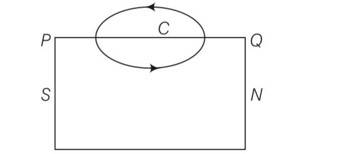Moving Charges and Magnetism
Get insights from 125 questions on Moving Charges and Magnetism, answered by students, alumni, and experts. You may also ask and answer any question you like about Moving Charges and Magnetism
Follow Ask QuestionQuestions
Discussions
Active Users
Followers
New answer posted
6 months agoContributor-Level 10
This is a Short Answer Type Questions as classified in NCERT Exemplar
Explanation- in the given figure let C be the amperian loop then,

= .dl
between B and dl is less than 90 degree so
= . dl>0
So magnetic field from south pole to north pole inside the bar magnet
So according to ampere law
=0
= + = 0
>0, so <0,
It will be so if the angle between H and dl is more than 90 degree so cos is negative . it means H must run from north to south pole .
New answer posted
6 months agoContributor-Level 10
This is a Multiple Choice Questions as classified in NCERT Exemplar
Explanation- for a charge particle to move in circular path
Mv2/r = qvB
v/r=w= bq/m
w= v/r = = T-1
New answer posted
6 months agoContributor-Level 10
This is a Multiple Choice Questions as classified in NCERT Exemplar
Explanation- force on charge particle due to both electric and magnetic field . now if electric force and magnetic field is zero then electric field and magnetic field is also zero.
Magnetic field is only responsible for constant velocity of charge particle if B=0 then E =0 if B is not equal to zero then electric field is also not equal to zero
New answer posted
6 months agoContributor-Level 10
This is a Multiple Choice Questions as classified in NCERT Exemplar
Answer- (b, c, d)
Explanation- magnetic forces on both the particles cause equal acceleration because they both have equal velocity
Also they both gain or loose energy because direction of force in both cases is opposite.
And there is no change in center of mass of particles so it is determined by B alone.
New answer posted
6 months agoContributor-Level 10
This is a Multiple Choice Questions as classified in NCERT Exemplar
Answer- (b, c)
Explanation- if current is in opposite sense the? Bdl = 0, also there exist a point where b and dl is perpendicular.
New answer posted
6 months agoContributor-Level 10
This is a Multiple Choice Questions as classified in NCERT Exemplar
Answer- (b, d)
Explanation- F=IlB, the direction of force is given by fleming's left hand rule and F is perpendicular to the direction of magnetic field. So work done is zero.
New answer posted
6 months agoContributor-Level 10
This is a Multiple Choice Questions as classified in NCERT Exemplar
Answer – (a)
Explanation- gyro magnetic ratio does not depend upon which electron is rotating.
New answer posted
6 months agoContributor-Level 10
This is a Multiple Choice Questions as classified in NCERT Exemplar
Answer. (d)
Explanation- W=MBcos , as the loop make 30 degree angle but angle made by axis of the loop with the direction of magnetic field, therefore work done is zero.
New answer posted
6 months agoContributor-Level 10
This is a Multiple Choice Questions as classified in NCERT Exemplar
Answer – (a)
Explanation – when a charge particle enter in cyclotron it will always accelerated with the help of oscillating electric field. But it will move with the same speed with the help of magnetic field.
New answer posted
6 months agoContributor-Level 10
This is a Multiple Choice Questions as classified in NCERT Exemplar
Answer- (d)
Explanation- when electron move in the direction of velocity along the axis of current then angle is 180 which makes force according to the relation F=qvbsin . so electron will continue move with uniform velocity along axis of solenoid.
Taking an Exam? Selecting a College?
Get authentic answers from experts, students and alumni that you won't find anywhere else
Sign Up on ShikshaOn Shiksha, get access to
- 65k Colleges
- 1.2k Exams
- 681k Reviews
- 1800k Answers
